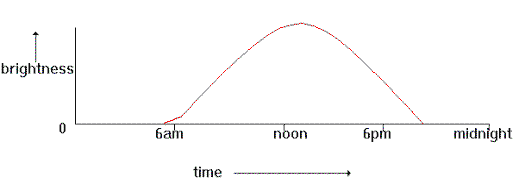Graphs are one way of showing the relationship between two variables (things that can change in value).

 This relates a dry battery voltage to time. It falls slowly over the weeks.
This relates a dry battery voltage to time. It falls slowly over the weeks.
This next graph shows a voltage which slowly rises from zero to a maximum value and then falls suddenly to zero again.
 This next graph shows the same thing happening but continues repeating. This is called a
WAVEFORM.
This next graph shows the same thing happening but continues repeating. This is called a
WAVEFORM.

The next waveform is called a square waveform because of its shape. It is at zero for a time and then shoots rapidly to a maximum value and stays there for a time before falling to zero again. It then repeats itself continuously.
 An OSCILLOSCOPE is used to display and measure waveforms.
An OSCILLOSCOPE is used to display and measure waveforms.
A common waveform is the SINEWAVE which can alternate between positive and negative voltages.
 Note that the horizontal line in all these graphs is called the X axis and
the vertical line is the Y axis.
Note that the horizontal line in all these graphs is called the X axis and
the vertical line is the Y axis.

The graph above shows how the brightness of the sun is related to the time of day.
From the start at the bottom left hand corner until just before 6 am
brightness is zero. (It is dark). Brightness increases as time passes
being at maximum about 1 pm when the sun is highest in the sky.
Brightness then falls becoming dark at about 9 pm when the sun sets. Now
look at the following graph.
This next graph shows a voltage which slowly rises from zero to a maximum value and then falls suddenly to zero again.


The next waveform is called a square waveform because of its shape. It is at zero for a time and then shoots rapidly to a maximum value and stays there for a time before falling to zero again. It then repeats itself continuously.

A common waveform is the SINEWAVE which can alternate between positive and negative voltages.


0 comments:
Post a Comment